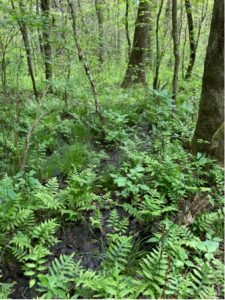Charles City County, VA – Protecting just a few acres of wetlands can make the difference between the hoped-for survival of a native plant species and its loss from our community. A rare Virginia native plant called the Virginia Least Trillium (Trillium pusillum var. virginianum) had its chances of long-term survival in the Commonwealth boosted this week. A Charles City County resident donated a conservation easement protecting 58 acres to Capital Region Land Conservancy (CRLC). The newly protected property contains over 21 acres of forested wetlands and is home to two populations of the rare plant. These plants and the habitat of many other plants and wildlife will be permanently protected from development and conversion to other uses under the conservation easement.
“Since the landowner had intentionally left the forested wetlands untouched for the last 35 years, we expected to find plant diversity on the property,” said Ashley Moulton, CRLC Land Stewardship Manager, “but to find this rare plant growing here made protecting the property under a conservation easement a statewide conservation priority.”

This easement supports Virginia’s water quality improvement goals for the Chesapeake Bay and the James River outlined in the 2014 Chesapeake Bay Watershed Agreement. Located along 900 feet of West Run, the protections required under this conservation easement provide water quality benefits by absorbing and filtering rain and nutrient runoff from the surrounding landscape. The conservation easement requires an extra layer of protection for the most sensitive areas: a 100-foot-wide riparian buffer along West Run and surrounding the property’s wetlands. The buffer (an area where disruption to the soil and vegetation is restricted) is meant to provide an extra level of sanctuary around a delicate resource. The wetlands found here are special in that they are fed year-round by a groundwater seep, where water migrates in and through the soil from natural springs. The resulting benefit of clean and healthy water will be felt downstream, from the banks of West Run to Lake Harrison, through Herring Creek, on to the James River, then all the way to the Chesapeake Bay.
A large patch of connected, undisturbed natural land—known as an ecological core—provides more benefits for wildlife than the same amount of land divided by roads, buildings, or other barriers. According to the Virginia Department of Conservation and Recreation’s (DCR) Virginia Conservation Lands Database (VCLD) rankings, nearly all of this property is designated as an ecological core. The Property scores “High” to “Very High” on the VCLD Forest Conservation Values model. The restrictions included in this Easement help ensure that large unfragmented cores are not disturbed by intensive development and the forest will continue in an unfragmented state by prohibiting commercial timber-harvesting.
Capital Region Land Conservancy was excited to find Virginia Least Trillium among a diverse community of wetland plants during our initial site visits with the landowner. The Virginia Least Trillium is imperiled and at risk of extirpation from the state due to a very restricted range and very few remaining populations. NatureServe—a nationwide database that tracks rare and endangered species-has recorded only 50 populations of Virginia Least Trillium—with 17 of those observations too outdated to be trusted and 2 of those now known to be ‘extirpated’ or locally extinct in areas where they were once found. Thanks to the landowners’ commitment to protecting this property forever under a conservation easement, the Virginia Least Trillium is a little more secure in the Richmond region.

# # #
About Capital Region Land Conservancy (CRLC): Incorporated in March 2005 as a non-profit 501(c)(3) organization, CRLC seeks to conserve and protect the natural and historic land and water resources of Virginia’s Capital Region for the benefit of current and future generations. Visit www.capitalregionland.org to learn more about CRLC’s land conservation programs.
For more information, contact Parker C. Agelasto, CRLC Executive Director at parker@capitalregionland.org or 202-302-0153.

